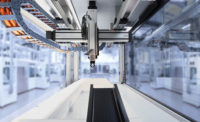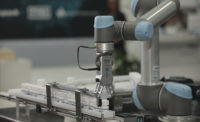Automation
Integrating Automation for Packaging Processes
The packaging automation realm needs to embrace change with new technologies.






Packaging is a constantly shifting environment. However, unlike the rest of production, packaging processes have been slow to uptake new technologies. Thankfully, with the rise of developments in technology, like sensors, human-machine interfaces (HMIs) and motion control, flexibility of the packaging line is better than ever.
That said, integrating automation for packaging processes is not without its challenges. With the increasing need to be capable of running several programs for different products, how can plant managers get this right, without breaking the bank?
Motion Control for Packaging
Motion control has been used in the manufacturing industry for decades, but only recent developments have allowed it to be used in other areas of production, such as packaging. Take food manufacturing for example. Packaging multiple products together requires synchronizing the incoming product, collating and grouping it, before transferring the product to a cartoning machine. All of this is expected at high throughput.
The efficiency of rapid changeover is one of the key advantages of motion control. Manufacturers have grown to expect to use a single appliance to package multiple products, therefore the ability to adjust the machine to package a different product in the minimum possible time is crucial.
Not only does motion control provide precision motion, but in the event of a fault, the system essentially acts as a braking mechanism, driving the machine to stop as quickly as possible. The feedback in motion control devices also evaluates the relationship between the actual value and wanted value, sending a signal to the drive for corrective action if needed.
Motion control is increasingly being used in processes that have been traditionally mechanical. For instance, tasks such as palletizing have long relied on pneumatic and hydraulics to operate. However, automated robotic palletizers provide much greater productivity, and accompanying motion control allows these powerful machines to synchronize seamlessly.
In today’s demanding market, motion control can offer manufacturers this increase in productivity, without having to upgrade their whole factory floor. The addition of programmable logic controllers (PLCs) provide a noise-free and inexpensive method of motion control, controlling multiple setups and logic control on machinery, as well as giving the best possible transfer speed.
Remote HMIs
HMIs play an important role in the connection of machines and the operators using them. However, they can provide much more information than simply displaying the machine’s current operation.
Interfaces can include speech recognition, motion sensors, keyboard and similar peripheral devices in which data from the factory is exchanged. What’s more, most supervisory control and data acquisition (SCADA) software systems can also be integrated on portable devices, meaning anything can become an HMI — whether it’s a screen on a piece of equipment, a laptop or a mobile phone.
These mobile HMIs allow operators to get instant access to HMI information and remotely monitor the application. Closely monitoring production and responding to changing customer needs from anywhere on the factory floor — or in fact, outside of it — improves efficiency of packaging processes.
Sensors for Upgrading
Increasingly, sensors are providing digital outputs instead of traditional analogue. This is important, as it incorporates higher transfer rates, transmitter reliability and self-diagnostic tools. But, what’s the case for sensors in packaging applications?
The main benefit with investing in sensors for automation is that equipment does not have to be upgraded for implementation. For facilities that require several different packaging processes to operate from the same area, using sensors to upgrade equipment is a much more conventional approach than investing in brand new automation for each individual packaging process. For instance, purchasing a six-axis robot for pick and place applications may also require a compatible conveyor for transporting — increasing the spend and footprint of this automation.
Adding sensors to the worst performing machine is another option. This allows plant managers to prove the concept before rolling it out to additional machines, eventually building the factory up in a modular way.
Automating packaging processes hasn’t been a priority for many manufacturers. However, there are a variety of options to do this without breaking the bank. Some as simple as fitting sensors to legacy equipment for more clarity in the process or creating a process that can be changed or investigated remotely.
Automation-mania hasn’t swept the packaging industry as quickly as Beatlemania spread during the 1960s, but it’s certainly gaining momentum. Automation is getting easier, and it is now more practical than ever for any company to implement, and ultimately further, their business goals.
EU automation supplies industrial automation parts to manufacturers across the US. Its global network of preferred partner warehouses and wholly owned distribution centers enables the company to offer a unique service within the automation industry, spanning the entire globe. EU automation provides worldwide express delivery on all products. For more information on EU Automation’s offering, visit euautomation.com.
Looking for a reprint of this article?
From high-res PDFs to custom plaques, order your copy today!









